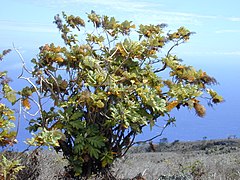Bocconia
| Bocconia subsp. var. | ||||||||||||||||||||||||||||||||||||||||||||||||||||||||
|---|---|---|---|---|---|---|---|---|---|---|---|---|---|---|---|---|---|---|---|---|---|---|---|---|---|---|---|---|---|---|---|---|---|---|---|---|---|---|---|---|---|---|---|---|---|---|---|---|---|---|---|---|---|---|---|---|

|
|
| ||||||||||||||||||||||||||||||||||||||||||||||||||||||
| ||||||||||||||||||||||||||||||||||||||||||||||||||||||||
Bocconia is a genus of the family Papaveraceae. It was named after the Italian botanist Paolo Boccone by Carolus Linnaeus, and contains about 10 species.
| Standard Cyclopedia of Horticulture |
|---|
|
Bocconia (after Dr. Paolo Bocconi, Sicilian botanist and author). Papaveraceae. Plume Poppy. Tree Celandine. Tall garden herbs, suitable to the hardy border. Herbs, but sometimes almost shrubby: glaucous: Lvs. lobed: fls. small, many, in terminal panicles; sepals 2, colored; petals wanting; stamens many: fr. a stalked caps., few-seeded.—Four or 5 species in American tropics, and China and Japan. The well-known China-Japanese species, B. cordata, is by some recent authors referred to Macleya, B. frulesr.ens and B. integrifolia (latter apparently not cult.) representing Bocconia as limited. The large, handsome leaves remind one, by their texture and lobing, of bloodroot and Stylophorum, which belong to allied genera. The flowers are very unlike our common poppies, being small and without petals, but they are borne in great feathery or plumy masses, in terminal panicles raised high above the heavy foliage, making the plant unique in its picturesque general appearance. Hence, it is much used for isolated lawn specimens, or for very bold and striking effects, being especially adapted to be viewed at long distances. It is also placed in shrubberies, wild gardens, and at the back of wide borders. It spreads rapidly by suckers, any of which, if detached, will make a strong plant in a single season. The plume poppy seems to be much hardier in America than in the Old World. It was popular early in the century, but was neglected, probably because it spread so rapidly. Lately it has become popular again. It deserves to be permanently naturalized in the American landscape. To produce the largest specimens, it is well to plant in very rich soil, give the old clumps liquid manure in spring, and cut off the suckers. Propagation chiefly by suckers. See Pflanzenreich, hft. 40, p. 217 for the latest monograph. B. integrifolia. Humb. & Bonpl. 9 ft.: fls. greenish: Lvs. nearly entire. Peru. Is sometimes cult.—B. macrocarpa, B. Giralda and B. Thunbergii are trade names, the first two referable to B. cordata, the last probably to B. microcarpa.
|
Cultivation
Propagation
Pests and diseases
Species
Gallery
References
- Standard Cyclopedia of Horticulture, by L. H. Bailey, MacMillan Co., 1963
External links
- w:Bocconia. Some of the material on this page may be from Wikipedia, under the Creative Commons license.
- Bocconia QR Code (Size 50, 100, 200, 500)
